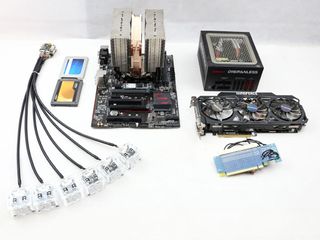Powenetics: A Better Way To Measure Power Draw for CPUs, GPUs & Storage
An Introduction To The Powenetics Project: Measuring Power Draw In The Lab
Tom’s Hardware is a global organization, with offices and labs in the U.S., France, and Italy that coordinate ahead of big graphics card launches. Performance testing typically comes from our lab in the U.S., while a German colleague works on power, acoustics, and thermals. A team of translators works tirelessly in the hours before those NDAs lift to stitch both pieces together for our respective audiences. With mere days between receiving cards and publishing reviews, it’s always a sprint to get a comprehensive story posted in time.
The power-consumption measurement hardware that our German colleague relies upon is quite the setup. It includes two multi-channel scopes, current clamps, slimline probes, and a 5 ¾-digit multimeter. In all, that's more than $10,000 worth of equipment. The work that went into setting all of this up allows us to characterize each card's consumption needs at idle, under extremely high loads, and everywhere in between. In fact, we were the first to break the news of Polaris’ tendency to draw too much current from the PCI Express slot in our AMD Radeon RX 480 8GB review, thanks to this hardware.
Unfortunately, it’s not easy to replicate that setup across all of our labs, for technical and economic reasons. So, we've been on the lookout for alternatives accessible to other editors. Our key wish-list criteria were lower-cost gear and ease of use, while not compromising accuracy.
Aware of our situation, Aris Mpitziopoulos, Tom's Hardware's power-supply reviewer, developed a solution called Powenetics in conjunction with Cybenetics. (See Aris' disclaimer at the end of this article.) Aris offered Tom's Hardware a pioneering role in the roll-out of Powenetics, providing the blueprints needed to configure our own power-consumption-measuring test bench and a premium version of the software, along with support to add features and fix bugs.
In the following pages, Aris will walk us through the composition of a Powenetics-capable test bench, explore its use, and present some preliminary results. But first, let's take a peek at the first Powenetics platform built in the Tom's Hardware U.S. lab...

The system employs a modified power supply, to which we attach a number of voltage/current sensors from a German company called Tinkerforge. Seasonic graciously provided its 1300W Prime Gold PSU for us to cut into, and Lian-Li sent over an open test bench for the whole configuration to live in.
A riser card is fitted out with two more Tinkerforge Voltage/Current Bricklet sensors for reading the PCI Express x16 slot's +12V and +3.3V rails.
Stay on the Cutting Edge
Join the experts who read Tom's Hardware for the inside track on enthusiast PC tech news — and have for over 25 years. We'll send breaking news and in-depth reviews of CPUs, GPUs, AI, maker hardware and more straight to your inbox.


The build process was spread over a couple of evenings. Nothing about the construction was particularly complicated, so long as you can get over the idea of cutting into modular power-supply cables to insert the Tinkerforge Bricklets in-line. Otherwise, soldering wires to the PCIe riser card was probably the toughest step (though it could have been easier with a second set of hands).
There's still work to do cleaning up all of the wiring to prevent short circuits, to be sure. But the hardware and software are very much functional in the lab, collecting data in a number of gaming, torture-test, and mining workloads.
Curious to learn more about how this collection of components and a custom-written utility can replace thousands of dollars' worth of lab gear? Read on!
Introducing Powenetics
Again, the Powenetics project was conceptualized by Cybenetics, a company you may have seen us mention for its work determining power-supply efficiency and noise levels. For this project, the purpose was to enable power-consumption measurements for graphics cards, storage devices, and CPUs. It's a combined hardware and software solution designed to be highly affordable, easy to use, and accurate (with fast polling rates to catch spikes that put a lot of stress on PSUs).

To keep the implementation cost low and to make the hardware as accessible as possible, the necessary components were chosen carefully. Not a single custom-made part is needed. The sensors used by the system come from Tinkerforge, while the PCI Express x16 extender is manufactured by Adex Electronics. Tinkerforge is located in Germany and ships its products worldwide. Adex is located in the U.S., but it has distributors in Europe, as well.

The power measurements this system generates are not based on Hall-effect sensors, but rather on current shunt resistors. This provides increased resistance to EMI noise. It also makes the installation easier, since you only have to install the graphics card as you normally would. That means there's no need to mess with current clamps.
Moreover, the system can be upgraded easily to support multiple graphics cards, to take readings from the EPS cable, or to accommodate additional hard drives. As it stands now, though, the basic version of Powenetics supports only one graphics card with up to three PCIe connectors, along with the power consumption of all three rails (+12V, 5V, and 3.3V) through a SATA cable. While it's entirely possible to install more than one SSD or hard drive on the same cable, yielding overall power consumption, the more practical application is one drive per cable, so as to isolate the individual devices.
An enhanced version of the Powenetics software makes it possible to collect CPU power measurements through the monitoring of up to two EPS cables.

Another reason to favor current shunt-based power measurements is that you get voltage information at the same time as current readings, yielding power. This isn't the case with Hall-effect sensors, with which you have to synchronize voltage and amperage data. With fast data-polling rates (in the 2ms range, for instance), this might be exceedingly difficult, given the latency of USB or Ethernet interfaces connecting measurement equipment to logging devices.
Each of the sensors used by Powenetics can measure 20A of current, 720W of power, and 36V. The minimum resolutions are 1mA, 1mW, and 1mV over the operating range, and bidirectional current measurements are also possible.
MORE: Best Power Supplies
MORE: How We Test Power Supplies
MORE: All Power Supply Content
Current page: An Introduction To The Powenetics Project: Measuring Power Draw In The Lab
Next Page The Hardware: The Gear We Use To Test Power DrawAris Mpitziopoulos is a Contributing Editor at Tom's Hardware US, covering PSUs.
Most Popular






